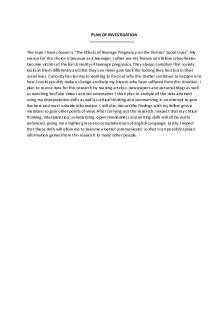Juniqua Whyte Caribbean History SBA PDF

| Title | Juniqua Whyte Caribbean History SBA |
|---|---|
| Author | Geron Elliott |
| Course | Introduction to Atlantic History |
| Institution | The University of the West Indies Cave Hill Campus |
| Pages | 13 |
| File Size | 374 KB |
| File Type | |
| Total Downloads | 25 |
| Total Views | 135 |
Summary
A brief and concise breakdown on aspects of Caribbean History....
Description
Candidate NAME: Juniqua C Whyte Candidate Number: 1300060554 Centre: Charles e. Mills Secondary School Centre Number: 130006 Subject: Caribbean History Teacher: Ms. Huggins Territory: St. Kitts Year: 2018 Candidate Name: Candidate Number:
Juniqua C Whyte 1300060554
Teacher:
Mrs. Huggins
Centre:
Charles E. Mills Secondary School
Centre Number:
130006
Subject:
Caribbean History
Territory:
St. Kitts
Year:
2018
Theme:
Topic:
Caribbean Economy and Slavery
“To what extent is it safe to say that the change from tobacco to sugar in the English-speaking Caribbean during the17th century was indeed a revolution?”
Rationale……………………………………………………………………………………….1 Introduction……………………………………………………………………………………2
Analysis of Data Social Consequences of the Sugar Revolution on the Caribbean……………………3 Economic Consequences of the Sugar Revolution on the Caribbean………………..7 Political Consequences of the Sugar Revolution on the Caribbean………………….8 Conclusion……………………………………………………………………………………9 Bibliography…………………………………………………………………………………10
Rationale
As a child, growing up here in St. Kitts, I heard my mom and dad reminisce about the sea of sugarcane plants that once dotted the landscape. During my third and fourth form years of Caribbean History, I learnt that sugar replaced tobacco as the main crop. The change from tobacco to sugar led to what is known as the ‘Sugar Revolution’. My curiosity grew more as to why a change in cash crop was deemed a revolution. Hence the topic: “To what extent is it safe to say that the change from tobacco to sugar was indeed a revolution?” By researching this topic I hope to unearth valuable information that will not only help me answer unanswered questions, but aid me in preparations for the upcoming CSEC examinations in May. It is my belief that the change from tobacco to sugar was not only a change in cash crop but a rewriting of Caribbean history. My intension is to examine the social, economic and political consequences of the change from tobacco to sugar. A number of secondary sources such as History books by: William Claypole and John Robottom, and Brian Dyde, Robert Greenwood and Shirley Hamber would be perused to gather data. Said data would be analyzed via statistics, direct quotes and a discussion of the literature and presented as an extended essay.
Introduction 1
Until mid-seventeenth seventeenth century the English-speaking colonies with the aid of the Kalinagos produced tobacco for export. By the 1640s the demand for West Indian tobacco had declined due competition from Virginia. The English settlers in the Caribbean realized that there was a great need for a new cash crop of greater profitability. The change from tobacco to sugar led to demographic changes, social stratification, introduction of African slaves on a larger scale and the change in the system of government. These changes were radical, complete and in some cases very drastic. As a result it is clear that the change from tobacco to sugar was indeed a revolution. Hence the topic: “To what extent is it safe to say that the Sugar Revolution was indeed a revolution?”
Social Consequences of the Sugar Revolution on the Caribbean 2
As stated earlier during the 1640s sugar became the only of importance. “The growth of the monoculture was much more than a spread of a profitable crop and a new market. It was a revolution which changed the whole racial composition and social structure of the islands.”1 The sugar revolution single handedly reduced the white population. “In nearly almost every case the white population declined, as smallholders and indentured servants working alongside each other on small plots were replaced by a relatively small number of wealthy plantation owners employing white servants in certain jobs on large plantations.”2While the number whites were systematically being reduced, the number of enslaved persons was rapidly increasing. See figure 1. Country Barbado
Year
White
Black
Total
1645
18 000
5 500
23 500
1712
12 500
52 500
65 000
1675
8 500
9 500
18 000
1722
7 000
80 00
87 000
s
Jamaica
Figure 1 Chart showing the changes in the population pre and post sugar. Sourced from Dyde, Hamber and Greenwood. A large reliable source of labour was necessary in order for sugar to profitable, hence increase in enslaved Africans. The smallholders who lost their lands as a result of the sugar revolution, refused to become wage owners, working alongside the enslaved on the sugar plantations. Some migrated to other islands but when the sugar revolution began on those islands, they left. While some became buccaneers, others gave up and returned to England. 1 Parry, J H et al. A Short History of the West Indies p64. 2 Dyde, Brian et al. History for CSEC Examinations: Amerindians to Africans 3rd Edition, p107.
3
As time progressed the white population dwindled proportionally everywhere; a new West Indian society emerged. “In its earliest form this, the sugar society, consisted of a small elite and mass of black slaves.”3 Rapid population growth took place; more than likely as a result of the importation of large numbers of enslaved Africans. Or it may be a direct or indirect result of the emergence of a coloured population. African women forced to mate with white slave masters often gave birth to mixed raced children. Finally, sugar provided substantial wealth; tobacco farming communities were replaced by a rich white plantocracy. The introduction of enslaved Africans not only altered the size of the population but also the ethnic composition. By the eighteenth century Caribbean societies became highly stratified, with the minority white planter class occupying the top rungs of the social ladder. Wealth, education and origin no longer determined an individual’s place in society. Race and colour were now the main determinants of social positioning. Whites, whether rich or not, were at the top, coloureds and free blacks were in the middle and the enslaved at the bottom.
Additionally, “Society changed from being over 90 per cent free before the sugar revolution to being over 90 per cent slave after it.”4 Being black meant inferiority and servility, while white meant superiority and dominance. “‘Free’ meant ‘white’ and ‘slave’ meant ‘black’. There were divisions within the two groups, but these were unimportant compared with the
3 Dyde, Brian et al, (See footnote 2), p107. 4 Dyde, Brian et al, (see footnote 2),p110.
4
cleavage of society into slave and free, or black and white.”5 Therefore, if you were black and rich you could never be considered upper class. Based on race poverty stricken white men were upper class, while wealthy black men were deemed middle class. Consequently a wealthy black man was automatically labeled inferior; to a poverty stricken and illiterate white man. On the other hand colour gradation determined an individual’s role and place in plantation society. See figure 2. Light skinned Africans lived in the Great House, ate the scraps off the dining table and wore planter’s hand me downs. Darker skinned Africans toiled in the fields, although those with a skill worked in the factories.
Figure 2 Social stratification of sugar colonies. Sourced from Honychurch, (2006) Society became fractured when enslaved Africans began arriving in large numbers. Fear, suspicion and control became the dominant features of social life as the enslaved Africans battled to regain freedom, and the ability to practice their culture. “The slaves arrived in the New World naked, and bereft of all the trappings of their culture, but in their new environment, they were able to revive or reconstruct much of what they had known, and so 5 Ibid.
5
before long, several aspects of their culture, including music, religion, customs like the burying of the navel string (umbilical cord), oral traditions, and dress were evident on the estate.” 6 The sugar revolution introduced a society where sexual abuse was either sanctioned or ignored. Sexual abuse of black women became an aspect of race relations. Additionally, “Slavery destroyed the network of kinship; family members were separated from one another, and the African customs of the extended family declined. Sometimes planters deliberately separated family members to try to destroy the man’s loyalty to anyone or anything other than the planter himself.”7
Economic Consequences of the Sugar Revolution on the Caribbean .
6 Hamilton -Willie Doris, Lest you forget A Study and Revision Guide for CXC Caribbean History: Caribbean Economy and Slavery, p 7 Ibid, p
6
The change from tobacco to sugar was significant in that it led to: an inflation of land prices, change in the demands of manufacture and introduction of a monoculture based economy. Land being scarce led to inflated land prices. “For example, a parcel of land of about 10 acres had been sold for £25 in 1630, which gives an average price of under £3 an acre. In 1648, when the sugar revolution was almost complete in Barbados, land was over £30 an acre.”8 Additionally, “The processing of sugarcane into sugar required expensive buildings, livestock and machinery and for these to be economically viable meant that large quantities of cane had to be produced.”9 This meant large acres of land had to be acquired, hence the increase in land prices. Also, “In order to extend the size of landholdings, a process of absorption occurred. Small estates adjacent to larger ones were acquired by various means.”10 Finally, with sugar requiring so much land, almost all available land was under sugar cultivation. This meant that planters had to concentrate on the cultivation of sugar only. In the English-speaking colony (Barbados) this led to monoculture; a dangerous base for their economy and a source of much distress. “This concentration on sugar soon resulted in the island being unable to grow enough food to feed its rising population.”11 Many planters were forced to import food from North America, which was fine during peacetime but wartime left them barely able to feed their labour force.
Political Impact of the Sugar Revolution on the Caribbean
8 Dyde, Brian et al, (see footnote 2), p107. 9 Taylor-Kanarick, Dr. Yvette. Caribbean History Themes, Volume 1. An Historical Survey of the Caribbean from Pre-Columbian era to Emancipation,p191. 10 Ibid. 11 Dyde, Brian et al, (see footnote 2), p109.
7
The change from tobacco to sugar gave rise to the introduction of the mercantile system, trade rivalry and a change in the system of government. The mercantile system was a system put in place, ensuring that Britain controlled the sugar trades and not the Dutch. “The Dutch because of their greater power or ability to give cheap credit and transport and facilities and to offer higher prices in their markets for West Indian products had secured for themselves markets which should have been available to England and France.” 12 It was geared at ending the Dutch’s trading
supremacy. “English trade was now to be confined to English shipping.”13 Also, “Remember that the Dutch were the main carriers of English colonial goods, so the Dutch merchants had to be replaced with English merchants.” 14 As sugar became more and more profitable European
nations fought to gain control of the trade. The end result being the many Caribbean islands changed hands often and the region became the cockpit of maritime warfare. Around 1660, the Proprietary System was changed to the Old Representative System. This change allowed Britain greater control over her now wealthy colonies. “Their show of wealth and the financial gains to be derived from their control, however, showed the wisdom of bringing the islands under more direct crown control.” 15
Conclusion
The change from tobacco to sugar was indeed a revolution, it brought about major social, economic and political changes in the Caribbean. It single handedly decreased the white population, increased the number of blacks in the Caribbean, created a mixed race 12 Dookhan, A Pre-Emancipation History of the Caribbean, p30. 13 Augier, F H et al. The making of the West Indies p46 14 Beckles Hilary MCD Verene A. Shepard Caribbean Indigenous Societies and Slave System, p.59 15 Dookhan, (refer to footnote 12), p51.
8
(mulattos) ; the end result being a highly stratified society based on race and skin colour. Additionally sugar cultivation led to a fractured society based on fear and suspicion. Rape of the enslaved women became part of Caribbean society. Ultimately sugar cultivation led to the decline in family structure and new families were created. Economically, sugar cultivation led to an increase in land prices due to supply being far less than the demand. Landholding increased in size, with the end result being a reduction in the number of small landholdings and the emergence of large plantations. Finally an economy dependent on monoculture led to the importation of food and the death of many labourers when food was scarce. Wars broke out which saw Caribbean islands changing hands as European nations fought to control the sugar trade, new maritime laws were also introduced and there was a change in the system of government; ensuring Britain had greater control of her colonies.
Bibliography
Augier, F. R, et al. The Making of the West Indies. Jamaica: Carlong Publishers (Caribbean) Limited, 2009. Claypole, William and John Robottom. Caribbean History: Foundations Book 1, 4th Edition. England: Pearson Education Limited, 2009. Dookhan, Isaac: A Pre-Emancipation History of the West Indies. United Kingdom: Longman 9
Group UK Ltd, 1988. Dyde, Brian, Robert Greenwood and Shirley Hamber. History for CSEC Examinations: Amerindians to Africans 3rd Edition. Oxford: Macmillan Publishers Limited, 2008. Hamilton-Willie, Doris. Lest you forget A Study and Revision Guide for CXC Caribbean History: Caribbean Economy and Slavery. Jamaica: Jamaica Publishing House limited, 2011. Parry, J H et al. A Short History of the West Indies, Fourth Edition. England: Macmilan Publishers Ltd, 1987. Taylor-Kanarick, Dr. Yvette. Caribbean History Themes, Volume 1. An Historical Survey of the Caribbean from Pre-Columbian era to Emancipation. Trinidad: Caribbean Educational Publishers, 2010.
10...
Similar Free PDFs
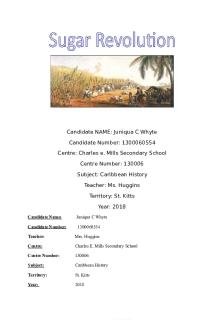
Juniqua Whyte Caribbean History SBA
- 13 Pages

CXC Caribbean History Notes
- 388 Pages

Background to Caribbean History
- 26 Pages

Math SBA - math sba csec
- 6 Pages

Dillon Whyte Resume 21
- 1 Pages

Essay 1 Caribbean Lit
- 5 Pages

Practice SBA Topology Notes
- 3 Pages

Principle Of Business SBA
- 13 Pages

Caribbean Internet Cafe
- 5 Pages

Theme 9 Caribbean Society
- 26 Pages
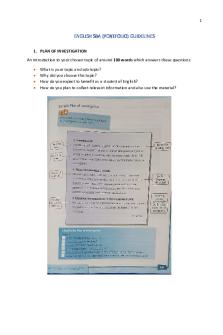
499708865 English SBA Guidelines
- 7 Pages
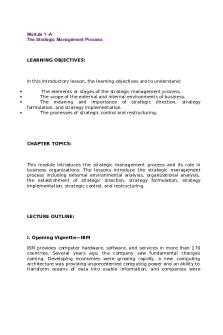
SBA MOD 1A & 1B
- 10 Pages
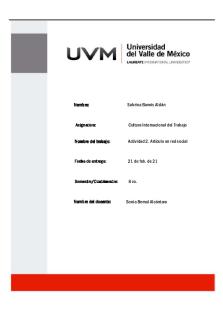
A2 SBA - TAREAS
- 6 Pages
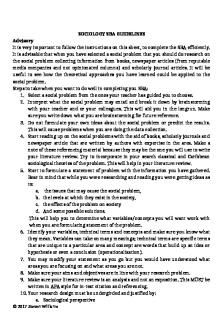
SOCIOLOGY SBA GUIDELINES
- 7 Pages
Popular Institutions
- Tinajero National High School - Annex
- Politeknik Caltex Riau
- Yokohama City University
- SGT University
- University of Al-Qadisiyah
- Divine Word College of Vigan
- Techniek College Rotterdam
- Universidade de Santiago
- Universiti Teknologi MARA Cawangan Johor Kampus Pasir Gudang
- Poltekkes Kemenkes Yogyakarta
- Baguio City National High School
- Colegio san marcos
- preparatoria uno
- Centro de Bachillerato Tecnológico Industrial y de Servicios No. 107
- Dalian Maritime University
- Quang Trung Secondary School
- Colegio Tecnológico en Informática
- Corporación Regional de Educación Superior
- Grupo CEDVA
- Dar Al Uloom University
- Centro de Estudios Preuniversitarios de la Universidad Nacional de Ingeniería
- 上智大学
- Aakash International School, Nuna Majara
- San Felipe Neri Catholic School
- Kang Chiao International School - New Taipei City
- Misamis Occidental National High School
- Institución Educativa Escuela Normal Juan Ladrilleros
- Kolehiyo ng Pantukan
- Batanes State College
- Instituto Continental
- Sekolah Menengah Kejuruan Kesehatan Kaltara (Tarakan)
- Colegio de La Inmaculada Concepcion - Cebu

